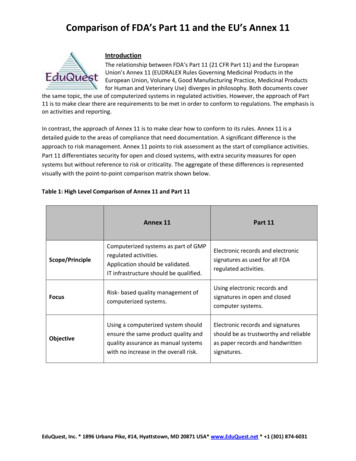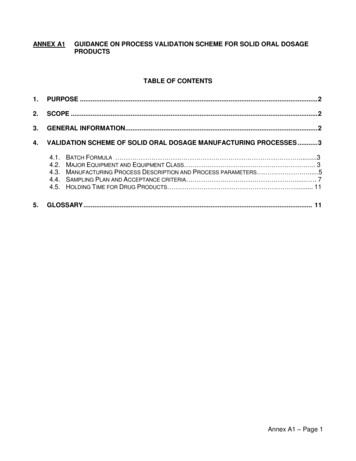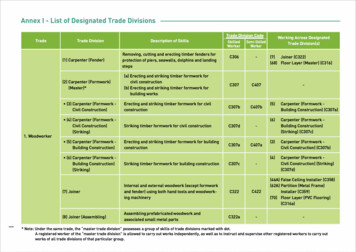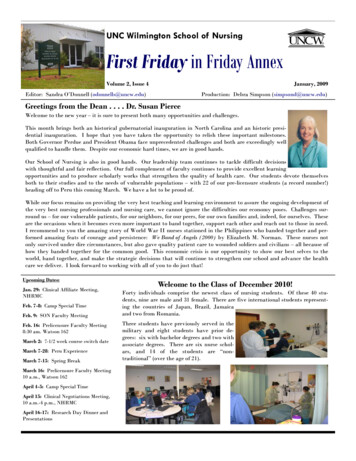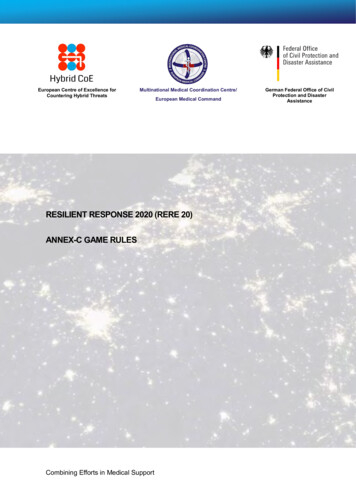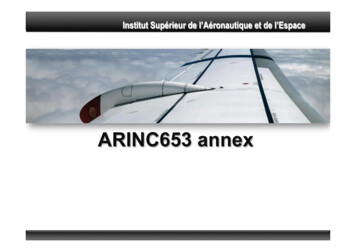
Transcription
Institut Supérieur de l’Aéronautique et de l’EspaceARINC653 annex
About AADL annexes AS5506/2 (January 2011)» Data Modeling Annex provides guidance on a standard way of associating datamodels expressed in other data modeling notations (C or ASN.1) with architecturemodels expressed in AADL,» Behavior Annex enables modeling of component and component interactionbehavior in a state-machine based annex sublanguage,» ARINC653 Annex provides guidance on a standard way of representing ARINC653standard compliant partitioned embedded system architectures in AADL models. AS5506/1A (October 2015 ?)» Code generation Annex defines language-specific rules for source text to becompliant with an architecture specification written in AADL;» Error Model Annex defines features to enable the specification of redundancymanagement and risk mitigation methods in an architecture, and enable qualitativeand quantitative assessments of system properties such as safety, reliability,integrity, availability, and maintainability.AADL Tutorial -- MODELS'152
About the ARINC653 standard ARINC653 aims at supporting the Integrating Modular Avionicsconceptual framework, evolution of federated architecture» Multiple functions are allocated on the same processor withspace and time isolation ARINC653 defines a set of software API for Safety-Criticalavionics Real-time Operating SystemsCockpitDisplaysAir DataComputerFlight MgtSystemAir DataComputerCockpitDisplaysFlight MgtSystemARINC653-compliant kernel, withtime and space partitioningARINC 429 buspage3
ARINC653 APEX APEX, the Application EXecutive API services:» Process, time, partition, sampling and queuing ports,» Buffer, blackboard, semaphore, event error management» Health management» With a C and Ada API The APEX is meant for modularity, portability» A few system calls, 53» Configuration through external XML files to reduce code/configuration coupling, delegation of responsibilitiespage4
Rationale for the ARINC653 Annex AADLv2 added concepts to support IMA systems Most important being the notion of “virtual processor”» A dedicated scheduling and memory space inside a processor Yet, many issues were still open» How to model blackboards, semaphores?» How to represent fault protection mechanism» How to take into account variability in APEX implementations? Goal of the ARINC653 Annex document» Define modeling patterns for IMA systems» Define additional property set when needed to clarify concepts Based on ARINC653-2, published in 2006page5
Mapping ARINC653 concepts ARINC module AADLv2 processor» AADL processor defines the OS configuration parameters» Additional properties for major frame, slot allocation, etc. ARINC partitions AAVLv2 virtual processor» Link to partitions as virtual processorsvirtual processor implementation acc partition.implend acc partition.impl;processor powerpc end powerpc;processor implementation powerpc.implsubcomponents-- ARINC653 partitions are subcomponents of the PowerPC componentpart1: virtual processor partitions::acc partition.impl{ ARINC653::Partition Identifier 1;ARINC653::Partition Name "acc"; };propertiesARINC653::Module Major Frame 150 ms;ARINC653::Module Schedule ( [Partition reference (part1); Duration 1 ms;Periodic Processing Start true;] );page6
Mapping ARINC653 concepts, cont’dOther mappings is semantic adaptation of concepts» ARINC 653 process AADLv2 thread Rationale: ARINC653 process are OS thread» ARINC653 queuing ports AADLv2 event (data) ports» ARINC653 sampling ports AADLv2 data ports Semantics are similar, with equivalent configuration parameters forqueue size, refresh period, etc.» ARINC653 buffers AADLv2 event data ports» ARINC653 blackboard AADLv2 data port or data components To model inter-process communication in the same address spacepage7
ADIRU, graphical representationPartitions andprocessesModuleAddress SpaceAADL Tutorial -- MODELS'158
AADL and XML configuration data ARINC653 Executives require an additional configuration file A (full) AADL model must define all components» For analysis or code generation purposes Can derive configuration file from the AADL model» Implemented in Ocarina, targets DeOS and VxWork653 Part of the model bus philosophy» One repository that can be mined for various purposes Analysis, code generation, management of configuration parameterspage9
Institut Supérieur de l’Aéronautique et de l’EspaceAADL and code generation
AADL and code generation AADL has a full execution semantics» Allow for full analysis: Scheduling, security, error, behavior Issue: what about the implementation ?» How to go to code?» While preserving both the semantics and non functionalproperties ? Solution: enrich AADL with annexes documents» To describe application data» To detail how to bind code to AADL modelsAADL Tutorial -- MODELS'1511
AADL objectives AADL requirements document (SAE ARD 5296)» Analysis and Generation of systems Generation can encompasses many dimensions1. Generation of skeletons from AADL components Like from UML class diagrams2. Generation of system archetypes Tasks, types, runtime configuration parameters, etc. In the following, we consider option #2» Supported by Ocarina, see http://www.openaadl.orgAADL Tutorial -- MODELS'1512
About data modeling annex Allow one to clarify actual representation of data» Integer, floats, etc. with Data Representation Actual size of data» 16/32/64 bits integers with Source Data Size Admissible range, precision Patterns for composite types, unions, etc. Based on a dedicated property set Data ModelAADL Tutorial -- MODELS'1513
AADL: modeling data types Solution: enhance definition of typesdata C Unsigned Long Int-- This data component defines a C unsigned long int type, with a-- dual nature The first properties defines its representation in-- memory, the two last its mapping in C.propertiesData Model::Data Representation integer;Data Model::Number Representation unsigned;Data Size 4 bytes;Source Language (C);Type Source Name "unsigned long int";end C Unsigned Long Int;data accData extends C Unsigned Long Intend accData;subprogram acc1 dataOutput spgfeaturesacc1DataOut: out parameter SHM DataType::accData;event in:in parameter SHM DataType::actionData;end acc1 dataOutput spg;AADL Tutorial -- MODELS'1514
AADL and subprograms Issue: how to bind user code ?» Solution: use default AADLv2 propertiessubprogram acc1 dataOutput spgfeaturesacc1DataOut: out parameter SHM DataType::accData;event in:in parameter SHM DataType::actionData;propertiesSource Language (C);Source Name "acc1dataoutput";Source Text ("./././acc code.o");end acc1 dataOutput spg;AADL Tutorial -- MODELS'1515
AADL and programming languages Issue: how to map source code ?» Solution: follow guidelines from the code generation annex» Mapping rules from AADL and the target language Similar to OMG IDL mappings for CORBAsubprogram acc1 dataOutput spgfeaturesacc1DataOut: out parameter SHM DataType::accData;event in:in parameter SHM DataType::actionData;end acc1 dataOutput spg;procedure acc1 dataOutput spg ( -- Ada(acc1DataOut: out SHM DataType.accData;event in:in SHM DataType::actionData);void acc1 dataOutput spg ( /* C */(acc1DataOut *SHM DataType accData,event in:SHM DataType actionData);AADL Tutorial -- MODELS'1516
Attaching code to components Connecting subprograms to threads» Connect ports to parameters» Use call sequence attached to threadthread acc1 dataOutputfeaturesacc1out: out data port SHM DataType::accData;acc1 command in: in event data port SHM DataType::actionData;propertiesDispatch Protocol Periodic;-- end acc1 dataOutput;thread implementation acc1 dataOutput.implcallssub1: { spg: subprogram subprograms::acc1 dataOutput spg;};connectionsC1: parameter spg.acc1DataOut- acc1out;C2: parameter acc1 command in- spg.event in;end acc1 dataOutput.impl;AADL Tutorial -- MODELS'1517
AADL and code generation Issue: How much code should we write ? Tasks ? Queues ? Answer: the architecture says all» One can define a full framework and use it Limited value» Generate as much things as possible Reduce as much as possible error-prone and tedious tasks Ocarina: massive code generation» Take advantage of global knowledge to optimize code, andgenerate only what is required» Support for regular RTOS (POSIX, Xenomai, FreeRTOS) andARINC653 APEX (DDC-I DeOS and WRS VxWorks653)AADL Tutorial -- MODELS'1518
Building process for HI-DRE systems using OcarinaAADL Tutorial -- MODELS'1519
Benefits of code generation ? Is it worth a try ? Of course yes ! One pivot notation based on a unique notation» A-priori validation, using Cheddar, TINA .» Optimized code generation Measures show a difference of 6% in size Part of the promise of MBSE» One binary, no source code written for the most difficult part: thearchitecture, buffer, concurrency» Could be combined with other code generators like SCADE orSimulink to achieve zero-coding paradigmAADL Tutorial -- MODELS'1520
Institut Supérieur de l’Aéronautique et de l’EspaceAADL & other MDEframeworksIntegration with Simulink, SCADE et al.
AADL and other modeling notations AADL helps modeling architectures» Capture key aspects of design: hardware/software» Expression of some non functional properties: priority, resourceconsumption, latency, jitter, » Enables: scheduling analysis, resource dimensioning, mappingto formal methods, fault analysis, Functional notations (Simulink, SCADE, .) describes preciselysystem behavior» Provides a high-level behavioral/computational view» mapped onto hardware/software elements Natural complement to ADLsAADL Tutorial -- MODELS'1522
”Zero coding” paradigm Code generation from models is now a reality» Proposed by many tools Functional models» kcg: SCADE’s certified code generation» Simulink Coder Architectural models» Ocarina: AADL code generator for HIsystems Foundations for a “zero coding” approach» Model, then integrate code generated from each view Issue: which integration process ?» Two approaches, driven by user demandAADL Tutorial -- MODELS'1523
Code generation patterns Each functional framework relies on same foundations» Synchronous: discrete computation cycles» Asynchronous: function calls SCADE/Simulink/Esterel: a 3-step process» Fetch in parameters from AADL subprograms» Call the reaction function to compute output values» Send the output as out parameters of the AADL subprogram Architectural blocks are mapped onto programming languageequivalent constructs» Ocarina relies on stringent coding guidelines to meet requirements for High-Integritysystems, validated though test harness by ESA, Thales, SEI, and their partnersAADL Tutorial -- MODELS'1524
From AADL X tocode Ocarina handles all code integration aspects» How to map AADL concepts to source code artefacts (POSIXthreads, Ada tasks, mutexes, .)» Handle portability concerns to several platforms, from bare tonative some knowledge on how a SCADE or Simulink models ismapped onto C code» So that integration is done by the code generator» No manual intervention required Supports “zero coding” approachAADL Tutorial -- MODELS'1525
Application-driven process Functions may be defined first, then refined to bebound to an existing architecture”SCADE/SimulinkAADLAADL Tutorial -- MODELS'1526
Architecture-driven process Reverse option: architecture is defined first, then a skeleton ofthe functional model is deduced, then implementedsubprogram spg scadefeaturesinput: in parameter integer {Source Name "add input";};output: out parameter integer {Source Name "add output";};propertiessource name "inc";source language Scade;source location "/path/to/scade-code/";end spg scade;AADL Tutorial -- MODELS'1527
How to bind to AADL models ? In both cases, we rely on standard AADLv2 patterns» Source Language - SCADE or Simulink» Source Name - SCADE node or Simulink block» Source Location - path to kcg orSimulink Codergenerated code Smooth integration of AADL and other functionalmodeling» Providing only required information» While remaining 100% automaticAADL Tutorial -- MODELS'1528
TASTE: DSML as inputs, AADL at its coreAADL Tutorial -- MODELS'1529
SCADE integration example Integrate SCADE on ARINC653 systems» Software behavior captured with SCADE» Architecture specified with AADL Auto-Generate Architecture and “glue code”» Generate ARINC653 configuration and partitions code» Different OS, same behavior No need for manual code» Smooth and integrated processhttp://aadl.info/aadl/demo-arinc653/AADL Tutorial -- MODELS'1530
Conclusion System are heterogeneous, so are models» AADL separates architecture from functional models» Allows reference from the architecture to function blocks Integration of AADL and SCADE or Simulink to perform fullgeneration of systems proved to be effective Advantages» “Zero coding” paradigm to ease integration work» Quality of code generated for both functions and architecture» Opens the path towards qualification/certification of complexembedded systems at model-levelAADL Tutorial -- MODELS'1531
ARINC 429 bus Air Data Computer Cockpit Displays Flight Mgt System ARINC653-compliant kernel, with time and space partitioning . AADL Tutorial -- MODELS'15 12 Allow one to clarify actual representation of data » Integer, floats, etc. with Data_Representation .
